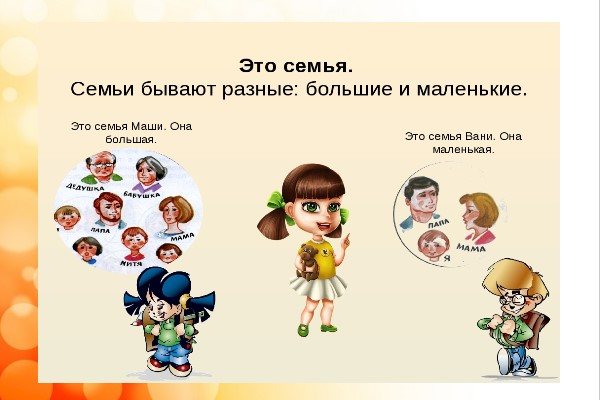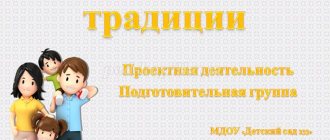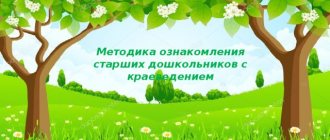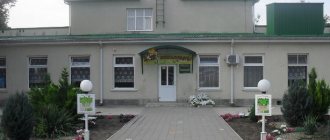Approximate summary of GCD: what we will do step by step
In general, the “My Family” lesson can be conducted according to the following approximate scenario:
- Children enter the group and sit on chairs. If this happens with music, it must be written down in “Materials and Equipment.”
- The link is the words of the teacher that the children have gathered here like a big family... by the way, what is a family? (listen to the answers). Define: “These are adults and children who live together, care for, love each other.” How do families show that they love each other? (listen to the answers). Here it is necessary that through speech children learn to talk about the relationships of loved ones.
- Invite children to play a game - for example, remember finger gymnastics. (This finger is grandfather, this finger is grandmother, this finger is dad, this finger is mom, this finger is me! That’s my whole family!).
- An offer to solve riddles about the family. There are a lot of them on the Internet, for example: “Before going to bed, putting on pajamas, we ask... (mom) to read.” Ask who each of the children is to the mother, as she affectionately calls him/her.
- Ball game. Invite children to pass the ball to each other, saying their mother's name. And then - again in a circle, describing my mother in words (kind, affectionate, loving, good).
- Dance “Helpers” to music. Invite the children to dance and show how they help their mothers (sweeping, tying shoelaces, putting away toys).
- Then all the same (riddle, ball game) about dad. He can be described in words: smart, caring, strong.
- Move from the word “strong” to physical education.
- Riddle about grandma. For example: “Fragrant jam, pies for a treat, delicious pancakes from your beloved... (grandmother).”
- Next are games related to grandma. Let's say, finger exercises (“I bake, bake, bake a pie for all the kids, and I’ll bake pancakes for my dear grandmother”). We remember the names of grandmothers and “help” them collect fruit for compote. Artificial fruits - write down in the props.
- Riddles and games about grandfather. For example: “He did not work out of boredom, his hands are calloused, and now he is old and grey, my dear, beloved... (grandfather).”
Plan for the practical lesson “My Family” in the group
The second part of the GCD is the actual lesson plan for children. Since a teacher is a creative profession, we can call the plan a script. If you write everything down in detail and to the letter, then it will be much easier to carry out later. Children's reactions to questions and games cannot always be predicted. But you can suggest if you see a misunderstanding, and take this into account next time.
At the beginning of the lesson you need to say hello, in the plan we write: “Greetings.” We write down the words that we will use to greet each other and that we will offer to say to the children. Since this is a certification class, it is highly advisable to say hello to the commission. Next come games and activities.
Preparatory (theoretical) part of the GCD
Let's look at the objectives of this lesson. They can be direct - to figure out who is who in the family, what they do. But next to the straight lines there will also be auxiliary ones. There are no standard tasks; they are prescribed specifically for the lesson. Exercises will then be selected for them. It is logical that program tasks and group activities during NOD correspond to each other.

So, tasks (goals) can be:
- Consolidate and systematize knowledge about family members and how they take care of each other, as well as their home.
- Foster positive emotions, love and respect for your family, pride in family members and your home.
- Enrich your vocabulary. For example, fix the names of family members, the names of fingers (if finger games are expected). And also activate words such as “mommy, daddy, kind, beloved, loves,” etc.
- Continue to develop fine motor skills (the same finger games, applique).
- Develop auditory attention, thinking and storytelling skills.
- Get joy from the work done and completed (for example, an application).
FGT requires that educational areas be integrated into the lesson and a game component be used. Therefore, after or before the “Goals” point, we make the “Integration of educational areas” point. It could be:
- cognition (when a holistic picture of the world is formed);
- communication;
- creativity (if the children draw, make appliqué, etc.);
- health (if there is physical education).
Among the types of activities may be gaming, communicative, creative, reading. It all depends on what practical tasks you include in the GCD.
MAGAZINE Preschooler.RF
Lesson summary: formation of a holistic picture of the world in the senior group. Topic: “My family”Goal: to develop the concept of “family” .
Tasks:
- “family” in children ; consolidate knowledge of the full names of family members; consolidate the ability to determine the name of family relationships between close family members;
- to cultivate in children humane feelings towards their loved ones, a desire to take care of them;
- enrich and activate children’s vocabulary on the topic of the lesson; develop creative storytelling skills, coherent speech skills;
- expand children's understanding of family holidays: Mother's Day and Family Day.
Equipment and materials: figures - baby mammoth family; pictures and a wonderful bag; ball; illustrations on the theme “I am learning from my grandfather” , “I am learning from my grandmother” ; chamomile.
Preliminary work:
- conversation about family;
- production of the “Family Tree” ;
- acquaintance with literary works: V. Oseeva “The Magic Word” , “Good” , “Sons” , “Took Revenge” , V. Kataev “The Seven-Flower Flower” , Russian people. fairy tales “Sister Alyonushka and Brother Ivanushka” , “Geese-Swans” ;
- reading poems, proverbs, sayings about family;
- role-playing games “home” , “family” ;
- looking at illustrations on the topic “family” ;
- watching cartoons: “Be careful, monkeys!” , "Umka" ;
- learning physical exercises and finger gymnastics;
- children making chamomile petals from colored paper.
Methodological techniques: game situation, dialogue, telling from a picture, using the disk “Baby Mammoth Song” .
Progress of the lesson:
1. Org. moment.
Good morning, dear guests.
-Good morning, children. I am glad to welcome you to our friendly circle.
I am very pleased that everyone is in a good mood today. I also feel a sense of joy that we have many guests today. And I really want the good mood to not leave you throughout the day. I invite you to hold hands, look tenderly into each other’s eyes and convey warmth, kindness, and a feeling of joy from our meeting.
2. Creating a game situation.
V. - Oh, guys! Look. Who is this? (children's answers). This is a baby mammoth.
Hello, baby mammoth.
M. - Hello. What is your name? (children answer.)
V.- Guys, why is he so sad?
V. - Baby mammoth, what happened?
M.- I went out for a walk and got lost. I can't find my family.
Q. - Guys, what is a family? (Children's answers). Right. This is mom, dad, grandfather, grandmother and brothers, sisters. Family is the most precious thing a person has. We must help the baby mammoth. Let's not waste time, go ahead! We will float on an ice floe. (While the children are seated on the floor where the ice floe is depicted, a song from the cartoon “Mom for the Baby Mammoth” ).
M. – Tell me what your mothers names are. (Children's answers).
V.- Say the best words about your mother, how (caring,
hardworking, gentle, affectionate, beloved, beautiful, kind...)? Mother
takes care of us: prepares food, washes, cleans, reads books, etc.
-How do you help your mother? (Wash dishes, sweep floors, wipe dust, etc.)
Physical exercise: Helping mom.
Together we help mom - we wipe the dust everywhere. Now we wash the clothes, rinse them, wring them out.
We sweep everything around and run for milk. We meet mom in the evening, we open the doors wide,
We hug mom tightly.
V. - Look, iceberg! Oh, it looks like there's someone there. Let's come closer and take a look. Baby mammoth, maybe your mother is there.
M. - Mommy!!!! It's so good that I found you!!! The guys helped me. Thank you.
Mother of the baby mammoth - Thank you very much. Baby mammoth, your dad is here
somewhere nearby.
V.- Mammoth calf, let’s continue the search for your loved ones.
M. - Guys, do you have dads? What are your dads names? What are yours? (Children's answers).
V.- Dad is brave, strong, hardworking, athletic, handsome, attentive, resourceful, cheerful, strict, honest, caring.
-Look, what kind of bag is this? (on the bag it is written “Wonderful bag” ). Wonderful bag! It says if we complete the task, the baby mammoth will find its dad. (game “What Dad Can Do” ). Now I will take out a picture, and you must answer what dad can do. For example, my dad knows how to drive a car... (children's answers).
M. - Miracles!!! Look, there's my daddy! And with him is my brother! Who has a brother or sister? (children's answers). Well done!!!
V.- Now let’s relax and play the game “Who am I?” Please all stand in a circle. (the leader in the circle with the ball, throws the ball to any participant and says: “I am a mother, and who are you to me? Son, I am a grandmother - you are a grandson, etc.) What do you guys think, who do we have left to find for the baby mammoth? ? (children's answers.) Grandfather and grandmother.
Guys, now look here! Let's look at the picture carefully. What are the grandson and grandfather doing? How does a grandfather teach his grandson to work? What did the grandson learn from his grandfather? Will the boy be able to fix his bike on his own next time?
And in this picture the grandmother is depicted with whom?…. (granddaughter). What are grandmother and granddaughter doing? How does a granddaughter help her grandmother? What did the grandmother teach her granddaughter? Will these skills be useful to my granddaughter in life? (children's answers).
M. - Well done! And here are my grandparents! I'm so glad!!!
V.- And we are happy for you! Really guys? (Yes).
- Mammoth calf. And our guys know what family holidays are. Tell them to the baby mammoth. (birthday, new year, etc.)
Guys, there is another very important holiday that is celebrated on the last Sunday of November - Mother's Day. This year we will celebrate it on November 27th.
And in the summer, on July 8, they celebrate the holiday - Family Day.
Finger gymnastics:
I know that I have a friendly family at home: This is my mother, This is me,
This is my grandmother, This is my dad, This is my grandfather. And we have no discord.
(Raise your hand with your palm facing you and, in accordance with the text of the verse, bend your fingers in a certain sequence, starting with the ring finger, then the little finger, index finger, middle and thumb).
The symbol of the family is the chamomile. So now we will make a chamomile, but not an easy one, a magical one that will fulfill your wishes. (Children glue a petal to the middle, making wishes).
Let's give it to the baby mammoth so that everything will be fine for him too!
3. Summary of the lesson.
V.- Guys, we helped the baby mammoth, and now we need to go back to the kindergarten. Let's sit on the ice floe and swim!!! (song from the cartoon “Mom for Baby Mammoth” ). What did you enjoy most today? (children's answers).
And I really liked how we all helped find the baby mammoth his family. Well done!!!
| Next > |




